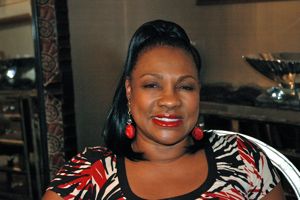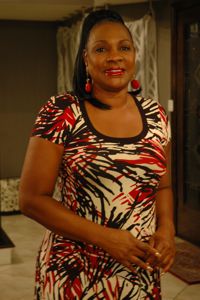Still Seeking Environmental Justice in New Orleans
Air Date: Week of August 27, 2010

Environmental justice activist Beverly Wright has worked to clean up contaminated soil and improve levee protection since Hurricane Katrina. (Photo: Steve Curwood)
If Hurricane Katrina exposed racial biases in public policy, environmental justice advocate Beverly Wright says post-Katrina rebuilding has shown not much has changed. The Dillard University professor says the whiter and richer communities in New Orleans have better access to grocery stores and hospitals and have gotten better levee protection from the Army Corps of Engineers than communities of color. Host Steve Curwood talks with Wright about her personal and professional experiences in the five years since the hurricane hit her home in New Orleans East.
Transcript
YOUNG: It’s Living on Earth. I’m Jeff Young.
CURWOOD: And I’m Steve Curwood in New Orleans.
[STREET AMBIENCE]
CURWOOD: Five years after Hurricanes Katrina and Rita, areas of downtown New Orleans and some neighborhoods look pretty good and function well. But not everywhere. I stopped by the house of environmental justice expert and Dillard University Professor Beverly Wright. She came back to rebuild her home in the black middle class neighborhood of New Orleans east.
CURWOOD: What happened in this house?
WRIGHT: Well, this house is very interesting it had 6-8 feet of water in it- completely destroyed. There was an alligator in the pool in the back. And, the whole house had to be gutted.
CURWOOD: It’s beautiful now. I mean I couldn’t tell walking in there that anything had ever happened.
WRIGHT: No, you really cant. That’s the beauty of this whole thing. There’s no reason for us not to come back because it can be rebuilt.
CURWOOD: So here it is 5 years on from Katrina, how are things here?
WRIGHT: Well, if I had to grade the city, I would say we’re about at a 5 on a scale from 1 to 10. But there are some areas of the city that are at a 9. So, really, how you’re doing depends on who you are and where you live. And it’s not necessarily connected to income. It is connected to skin color. And African Americans, who made up 80% of the people affected by Katrina, are not doing as well as white people who make up 80% of the persons who have come back home.
In New Orleans east for example, we have one supermarket. I went to the supermarket yesterday. I could get no lettuce, you know, no fruit…all the fruit gone. It was just amazing. 70,000 people, one supermarket in New Orleans east. That’s it. And I have to tell you, I’ve not been a big McDonald’s fan, but after Katrina, if it weren’t for McDonald’s we wouldn’t have had anything to eat. It was like people just forgot about us.
CURWOOD: So, how would you explain what happened to New Orleans in environmental justice terms.
WRIGHT: Well, the environmental injustice occurs in a number of ways. The fact that, first of all, when you look at the federal level they never addressed soil contamination that exists all over the city.
CURWOOD: What are the contaminants that are in the soil here?
WRIGHT: We have extremely high arsenic levels, and PCBs, cause where we live we use a lot of pesticides; we have a lot of pests. From rat poisoning, to pesticides for roaches and mosquitoes, you already have all of that, right, and then you add to that the big mixture that came in all the water from all over, even from the bottom of Lake Pontchartrain, then you add to that human feces and everything from the sewage treatment plants. That water was extremely filthy. And very dangerous. And then it settled. There was a light dust that covered everything when we came back home. And what is just amazing about this is that it was an easy fix.
And the army corps of engineers had, in the first few weeks after the storm, come up with a remedy. They were literally going to scrape dirt off the whole city. New Orleans would have been the cleanest urban area in the country. Well, some politicians decided that if they did they they’d never get the city back…it would have the reputation for being a superfund site. My thing was, if you’re not going to protect the citizens at least tell them what they need to do to protect themselves.

Professor Wright in her home in New Orleans East, which was flooded by 11 feet of water during Hurricane Katrina. (Photo: Steve Curwood)
So we started the Safeway Back Home campaign, where people remediated their own properties and planted new grass, and so on. And the block that we worked on, there was one lady who didn’t have much grass. So she decided when she saw the mounds of dirt that she didn’t want to be bothered with that. So she went outside sweeping up her patio, she broke out with a rash from her head to her toe.
CURWOOD: So, how far has the self-remediation program gone?
WRIGHT: I would say not far enough. We’ve been concerned because New Orleans has a history of backyard gardening. So when I was a kid everybody had a garden. If you didn’t have one, you ended up with one because the vines would start to grow across the fence and so you’d end up with tomatoes and what we call meliton, which is a Japanese plum. You’d have okra just showing up in your yard. So I grew up with things growing in my yard that we ate. And, so it’s an old tradition and it’s been difficult for us to try to get the word out to people, do not eat the vegetables that are growing in your yard unless you’ve had your yard tested or use raised gardens.
CURWOOD: So, what are the other environmental justice issues that come out of the Katrina experience?
WRIGHT: Well, levy protection for one, was one the biggest ones. And we’re still dealing with that. I mean, even after all the money that was put in place, wealthy and white got better protection than the rest of us. So I went to the army corps of engineers meetings to find out, what is this process and how is this happening? And this is what we were told: that rich white folks were in the plan for better protection some 15, 20 years ago. And so their projects were already in the hopper. So when things get fast-tracked, what’s in the hopper comes out first. So they ended up ahead of us again. So it was a lesson for us, you know, try and understand how does this work?
CURWOOD: Let’s talk about the oil disaster and the environmental justice aspects of that. Even as far north from the Gulf as here in New Orleans.
WRIGHT: You know it’s amazing to me that whenever they talk about fishermen and they don’t show black fisherman, it’s a HUGE crew. And think about it now. If we were not allowed to go to school, we had to make a living some way. If it wasn’t on a plantation, what would black people do to earn a living in Louisiana? They’d become fishermen and oystermen and stuff. And they’re 10,000 deep in some of the parishes, in Plaquemines Parrish and so on. But they were invisible.
I think that certain cultures that have made Louisiana distinct could disappear. When certain lifestyles disappear, then a certain part of that culture that has been maintained can also disappear. So we’re about—we could lose our difference. My hope is for the future with young people. I would say that young people are not NEARLY as racist as what we used to be. And I think they see a completely different world and I’m so happy that that is the case.
CURWOOD: Professor Beverly Wright directs the Deep South Center on environmental justice at Dillard University in New Orleans.
[MUSIC: Eddie Bo: Mardi Gras In The Boileroom” from New Orleans Solo Piano (Night Train International 2006)]
Links
Learn more about the Deep South Center for Environmental Justice.
Click here to read a Washington Post on the uneven recovery.
Click here to listen to an extended interview with Beverly Wright
Living on Earth wants to hear from you!
Living on Earth
62 Calef Highway, Suite 212
Lee, NH 03861
Telephone: 617-287-4121
E-mail: comments@loe.org
Newsletter [Click here]
Donate to Living on Earth!
Living on Earth is an independent media program and relies entirely on contributions from listeners and institutions supporting public service. Please donate now to preserve an independent environmental voice.
NewsletterLiving on Earth offers a weekly delivery of the show's rundown to your mailbox. Sign up for our newsletter today!
 Sailors For The Sea: Be the change you want to sea.
Sailors For The Sea: Be the change you want to sea.
 The Grantham Foundation for the Protection of the Environment: Committed to protecting and improving the health of the global environment.
The Grantham Foundation for the Protection of the Environment: Committed to protecting and improving the health of the global environment.
 Contribute to Living on Earth and receive, as our gift to you, an archival print of one of Mark Seth Lender's extraordinary wildlife photographs. Follow the link to see Mark's current collection of photographs.
Contribute to Living on Earth and receive, as our gift to you, an archival print of one of Mark Seth Lender's extraordinary wildlife photographs. Follow the link to see Mark's current collection of photographs.
 Buy a signed copy of Mark Seth Lender's book Smeagull the Seagull & support Living on Earth
Buy a signed copy of Mark Seth Lender's book Smeagull the Seagull & support Living on Earth

